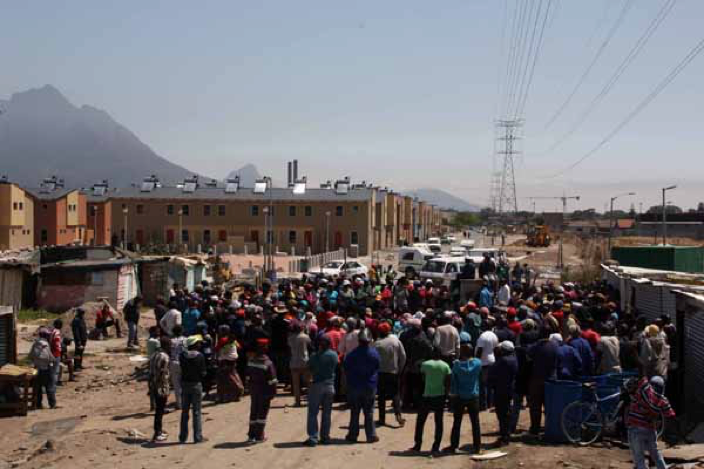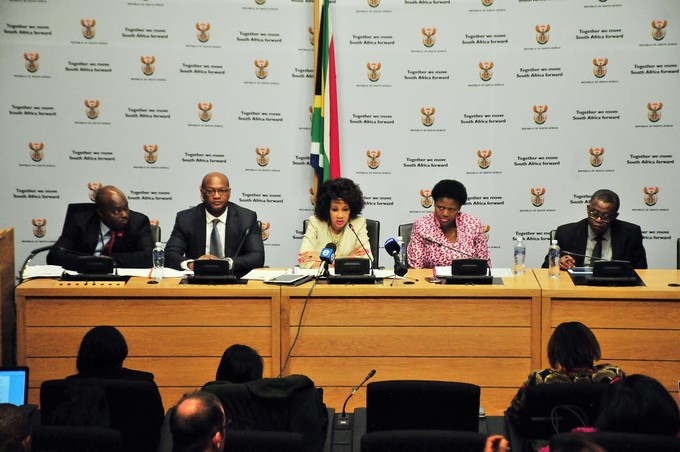Experts caution government over new housing mega-projects
The Department of Human Settlements has announced a change in focus, but experts say it may not be the best way to deal with the housing crisis
In a speech to Parliament on 3 May, Minister for Human Settlements Lindiwe Sisulu proposed sweeping plans to invest R90 billion into so called ‘catalytic projects.’ According to her, these projects will trigger R150 billion in private investment, and reach a total worth of R300 billion. The end goal: to quickly provide large numbers of houses to those in need by centralising the efforts of the government and involving the private sector.
Sisulu said 101 projects had been identified and 94 of them were ready to begin as soon as paperwork is completed. She said a full list would be released to the public on 9 May. However, more than a month after the deadline, no list has been made available.
In November last year, the Department of Human Settlements released a draft white paper on human settlements meant to guide discussion for a new policy that would completely replace the Housing Act of 1997. It recommended mechanisms to establish public-private partnerships and focus the role of the department on identifying areas which could quickly be released to developers.
Together, the recent speeches by Minister Sisulu and the Draft White Paper on Human Settlements entail a massive shift in government policy. Instead of focusing on many small-scale housing projects, the government will now only consider projects that will provide completely integrated settlements and deliver a large number of houses.
Additionally, the department will act as the centre for all communication and oversight, a substantial change to centralise current partnerships between stakeholders and government.
Of the projects, 46 are explicitly defined as “mega city” projects that build completely new cities, instead of providing housing within existing urban centres.
N2 Gateway Project
In her speech, Sisulu mentioned the N2 Gateway Project as one of the inspirations for the department’s new focus. The project was initially intended to provide 25,000 homes in Delft, 30km drive from Cape Town’s city centre. Like these new projects, the N2 Gateway was a partnership between all three spheres of government and the private sector. The national department, Western Cape government and the City of Cape Town coordinated to provide the land and oversight on the project. Thubelisha, a private company, was given the mandate to implement the project.
By 2009, Thubelisha was on the verge of running out of money. Additionally, controversies had arisen from evictions that had been carried out to clear the land for the project.
In a Parliamentary briefing on 7 July 2009, Thubelisha announced that it would withdraw from the project due to financial concerns and its failure to meet deadlines. It noted that it had struggled with reconciling the needs of people and the needs of large developers. Additionally, it mentioned that possibly differing expectations from the three levels of government had confused the overall specifications and goals of the project.
In order to open land for initial development, the national and Western Cape governments sought and acquired an eviction order for 1,000 residents of the Joe Slovo Township in 2007. They were moved to a temporary relocation area in Delft.
When the national and Western Cape government attempted to carry out a further eviction of 20,000 residents of Joe Slovo informal settlement, they faced extensive legal challenges. The residents argued that the government had not even considered if it was worth upgrading the settlement before opting for demolition. In a highly controversial series of court rulings, the Constitutional Court allowed the evictions to proceed, but formally noted that the government should have attempted to upgrade the settlement. However in 2009, the Constitutional Court reversed its rulings and put a stop to the eviction.
Today, the national Housing Development Agency (HDA) is in charge of the project and aims to deliver 15,000 residential units. Established in 2009, the HDA is a national agency within the Department of Human Settlements, charged with acquiring and releasing land for housing and providing project management and support at the request of provinces and municipalities.So far, says the HDA, that 12,000 units have been completed and given to people. in the N2Gateway Project.
Yet nine years later, many of the residents initially evicted remain in the “temporary” settlement that is now notorious for its lack of jobs, schools, and public safety.
To many, the N2 Gateway Project stands out as a failure because it lost touch with the expectations of the people it was supposed to benefit. A report by the Centre on Housing Rights and Evictions found that the project had failed to involve community participation, and that project managers had stubbornly attempted to push forward with a simple “big picture” instead of evaluating solutions aligned with the needs of the community.
Another study , by the Development Action Group, also pointed to the lack of community participation as the key point of failure. The study also found that public-private partnerships require much more oversight, in order to “protect the poor from profit-driven developers”. In its testimony to Parliament, Thubelisha had voiced problems in balancing the goals of large developers with the needs of the community.

Projects similar to N2 Gateway
For many who were concerned with the N2 Gateway Project, the national government’s shift to similar mega-projects may result in similar problems. As with the N2 Gateway, these projects would prove disastrous if they failed to connect to sources of economic opportunity and did not involve communities from the outset.
The minister described the department’s new vision as a “framework that allows government to play its part while encouraging the market to participate as a full partner.” The emphasis on partnering with the private sector without mention of the local community is what the Centre on Housing Rights and Evictions and Development Action Group found to be a fault line in the N2 Gateway Project.
Ivan Turok, executive director of the Human Sciences Research Council, has conducted research in urban planning, economic development and local labour markets. In November, he published an article expressing concern with government mega-projects. In his view the emphasis on such large projects is dangerous, as they do not address underlying community issues, carry much greater risks, do not offer smooth access to existing job opportunities, and are financially insecure.
Yet the largest problem, to him, is that such “big projects are difficult to fit into the existing urban fabric and social conditions. They create somewhat artificial new environments and do nothing to address the immense challenges facing our existing cities. They bypass the problems.”
He pointed out that in Cosmo City, another mega-project that the minister had cited as a success and inspiration, it took “nearly a decade for supermarkets, petrol stations and other formal retail outlets to open there, let alone tradable activities”.
Turok said the lack of information, such as the actual list of projects or specific policy, and the absence of any specific reference to mega-projects in the draft white paper, were a concern. For such large-scale projects to succeed, clear frameworks and communication channels were essential.
In a follow-up speech to the National Council of Provinces on 19 May, Sisulu claimed that 94 of the projects were “ready for implementation as soon as we conclude paperwork”. In the absence of any published list, or details of these projects, it is impossible to determine if community participation has been placed front and centre.
Turok’s concerns are widely shared by organisations within the field. When the draft white paper was released last year, five urban sector NGOs published a letter describing their concerns with the proposal. They claimed that proposed solutions did not take into account local stakeholders and that it was not appropriate for the national Department of Human Settlements to take such a central role in managing the projects. Rather, policy should focus on “enabling local actors (municipalities, communities, civil society organisations, private sector etc) to choose the institutional arrangements and programmatic responses that best suit local conditions”.
This draft white paper is not official policy. The recent speeches made by Sisulu indicate the department will be forging ahead with these large-scale projects. But no official policy framework has been released.
Turok feels that the government should be focusing on promoting densification in urban centres. In a research paper published in November last year, he recommended that housing policy should promote the development of unused urban spaces, mixed-income residential schemes, and continuous upgrading to current settlements. He admits that this may not have the political charm of a large project, but points to examples such as Johannesburg’s Braamfontein neighbourhood and the Trust for Urban Housing Finance which demonstrate that smaller scale, more complex solutions have better long-term outcomes and sustainability.
Government response
In December, the Housing Development Agency directly responded to concerns over mega-projects by clarifying that not all the “catalytic projects” were necessarily going to be mega-cities. As long as proposed projects had the ability to deliver appropriate infrastructure, integrated compact cities, and a large impact on social transformation, they would be considered.
In order to alleviate concern that these new mega-cities may further apartheid-era urban planning methods, the HDA released a Master Spatial Planning document that lists the criteria and goals according to which the state prioritises development initiatives.
The HDA believes that the document establishes a clear process and would form the “cornerstone of the country’s entire human settlement policy going forward.” But the Master Spatial Planning document did not address problems that Turok and urban-sector NGOs had raised with centralising projects at the national level. The HDA simply stated “the National Department of Human Settlement will guide spatial planning and indicate where to invest in human settlement through a single national project pipeline.”
It should also be noted that the national department has taken steps to increase community involvement. At all levels of government, a process known as “enhanced housing people’s process programme” (ePHP) seeks to put individuals and communities in charge of working to upgrade informal settlements and enhance rural development.
Urban-sector NGOs, community organisations, and the government have all lauded ePHP projects as a successful way to improve communities.
In a speech following Sisulu’s 19 May address to Parliament, Deputy Minister Zou Kota-Fredericks emphasised the importance of the ePHP process in guiding the focus of the national department.
Requests for comment from the National Department went unanswered.
The article originally stated that Delft is 40km from the city centre. It is in fact 30km drive from the city centre.
Support independent journalism
Donate using Payfast

Don't miss out on the latest news
We respect your privacy, and promise we won't spam you.
© 2016 GroundUp. 
This article is licensed under a Creative Commons Attribution-NoDerivatives 4.0 International License.
You may republish this article, so long as you credit the authors and GroundUp, and do not change the text. Please include a link back to the original article.

